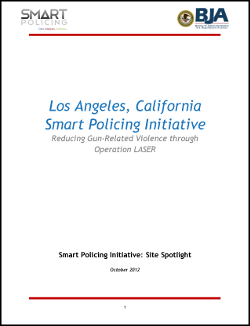
The Los Angeles Smart Policing Initiative (SPI) sought to reduce gun-related violence in specific neighborhoods in the city of Los Angeles, through application of the SARA problem-solving model—Scanning, Analysis, Response, and Assessment. As part of the scanning phase, the LAPD and its research partner examined gun-related crimes by Division and by Reporting District for 2011. In 2011, the Newton Division was ranked third in gun violence among the 21 Divisions.
The Los Angeles SPI team next sought to identify specific areas for intervention in the Newton Division, employing a geographic analysis of data on gun-related crimes, arrests, and calls for service over a six-year period (2006-2011). The location-based analysis resulted in the identification of five large hotspots.
Once the target areas were identified, the Los Angeles SPI team developed their intervention strategy, called Los Angeles’ Strategic Extraction and Restoration Program (Operation LASER). Established in September 2011, Operation LASER’s overall goal is to target with laser-like precision the violent repeat offenders and gang members who commit crimes in the target areas. LASER involves both location- and offender-based strategies, most notably the creation of a Crime Intelligence Detail (CID). CID’s primary mission centers on the development of proactive, real-time intelligence briefs called Chronic Offender Bulletins. The bulletins assist officers in identifying crime trends and solving current investigations, and they give officers a tool for proactive police work.
The Los Angeles SPI team assessed the impact of Operation LASER using Interrupted Time-Series Analysis. In particular, the team analyzed monthly crime data for the Newton Division and 18 other divisions from January 2006–June 2012. Results show that Part I violent crimes, homicide, and robbery all decreased significantly in the Newton Division after Operation LASER began. After the program was implemented, Part I violent crimes in the Newton Division dropped by an average of 5.4 crimes per month, and homicides dropped by 22.6 percent per month. Importantly, the crime declines did not occur in the other LAPD divisions, which provide strong evidence that Operation LASER caused the declines in the Newton Division.
The Los Angeles SPI experience offers a number of lessons learned for both police managers and line officers. The initiative underscores the value of the SARA model as an evidence-based framework for crime control, and it highlights the central role of both crime analysis and technology in data-driven decision-making. The Los Angeles SPI invested heavily in the relationship between line officers and crime analysts, and the investment paid off in sizeable reductions in gun-related crime in the target areas. The initiative also demonstrates the importance of focusing intervention strategies on both people and places to achieve success in crime control and prevention.
